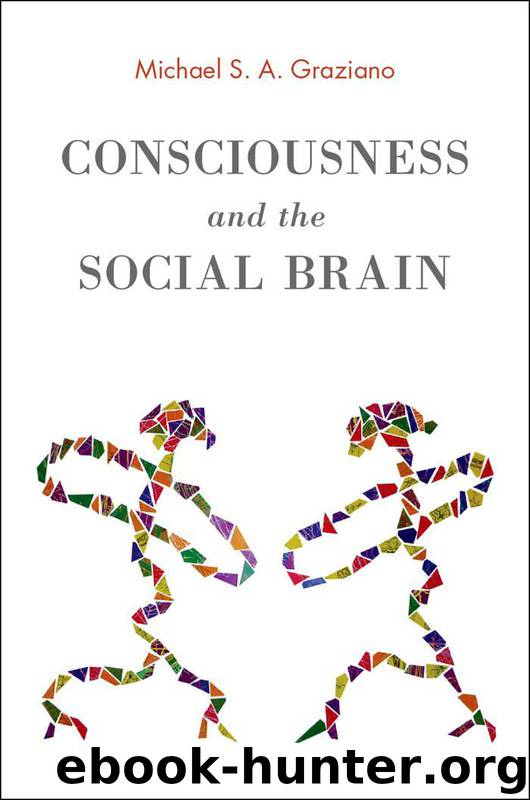Consciousness and the Social Brain by Michael S. A. Graziano

Author:Michael S. A. Graziano
Language: eng
Format: mobi, epub
Publisher: Oxford University Press
Published: 2013-07-31T14:00:00+00:00
11
Consciousness as Integrated Information
In the previous chapter I discussed one of the most common theoretical approaches to consciousness—the social construction of consciousness. A second common theoretical approach is to attribute consciousness to informational complexity and in particular to the linking, or binding, or integration of information in the brain. The social approach and the integrated information approach to consciousness are quite different and in some ways have been viewed as rivals. Yet the attention schema theory could be seen as a way of fusing the two approaches.
In the attention schema theory, awareness is a computed feature. It is descriptive information—call it information set A. To be aware of X is to bind or integrate the information that depicts X with the information set A. When you report that you are aware of X, it is because cognitive machinery in your brain has accessed that large, brain-spanning set of information, A + X, and is summarizing it. You are reporting that X comes with the properties of A attached to it. The attention schema theory works only so far as the proposed attention schema can be bound to other chunks of information. It is an integrated information approach to consciousness just as much as it is a social approach.
This chapter describes the integrated information approach to consciousness, beginning with the early versions of that line of thinking, and then discussing some of the potential strengths and weaknesses of the approach and how it may relate specifically to the attention schema theory.
Integrated Information Theories
In 1983, Baars1,2 proposed the global workspace hypothesis, one of the first well-articulated theories of consciousness as integrated information. In that theory, information spanning many brain areas can be linked or bound into a single, coherent whole, and that brain-wide pool of information forms a global workspace that encompasses the contents of consciousness.
The neural basis for binding information across widespread brain areas is not yet known, but one hypothesis has been investigated in some depth. In 1990, Singer and colleagues3 were studying the visual system of the cat and discovered that under some conditions the neurons were active in rhythmic bursts. These bursts occurred about 40 times per second in a regular oscillation. Moreover, different neurons that were spatially separated from each other in the cortex could oscillate in synchrony with each other.
In theory, two neurons that are active in synchrony form a powerful information unit. A single neuron, sending a signal, may fail to impact the downstream circuitry, or impact it in a marginal way that does not rise above the level of random fluctuation. But two or more neurons firing in synchrony, sending their signals to the same downstream collector, can have a coherent impact that rises above the background noise. Singer and colleagues proposed that the synchronization of neurons was a means of binding together the information carried by those neurons into a single informational unit. When one neuron caries information A, and another neuron carries information B, and those two neurons are active in synchrony,
Download
Consciousness and the Social Brain by Michael S. A. Graziano.epub
This site does not store any files on its server. We only index and link to content provided by other sites. Please contact the content providers to delete copyright contents if any and email us, we'll remove relevant links or contents immediately.
| Administration & Medicine Economics | Allied Health Professions |
| Basic Sciences | Dentistry |
| History | Medical Informatics |
| Medicine | Nursing |
| Pharmacology | Psychology |
| Research | Veterinary Medicine |
The Art of Thinking Clearly by Rolf Dobelli(10142)
The 5 Love Languages: The Secret to Love That Lasts by Gary Chapman(9518)
Mindhunter: Inside the FBI's Elite Serial Crime Unit by John E. Douglas & Mark Olshaker(9105)
Becoming Supernatural by Dr. Joe Dispenza(8040)
The Road Less Traveled by M. Scott Peck(7475)
Nudge - Improving Decisions about Health, Wealth, and Happiness by Thaler Sunstein(7460)
Mastermind: How to Think Like Sherlock Holmes by Maria Konnikova(7164)
Enlightenment Now: The Case for Reason, Science, Humanism, and Progress by Steven Pinker(7084)
Win Bigly by Scott Adams(7033)
The Way of Zen by Alan W. Watts(6452)
Factfulness: Ten Reasons We're Wrong About the World – and Why Things Are Better Than You Think by Hans Rosling(4629)
The State of Affairs by Esther Perel(4588)
Gerald's Game by Stephen King(4514)
Man's Search for Meaning by Viktor Frankl(4357)
The Confidence Code by Katty Kay(4158)
Thinking in Bets by Annie Duke(4121)
Hidden Persuasion: 33 psychological influence techniques in advertising by Marc Andrews & Matthijs van Leeuwen & Rick van Baaren(3416)
The Healing Self by Deepak Chopra(3405)
The Worm at the Core by Sheldon Solomon(3397)
